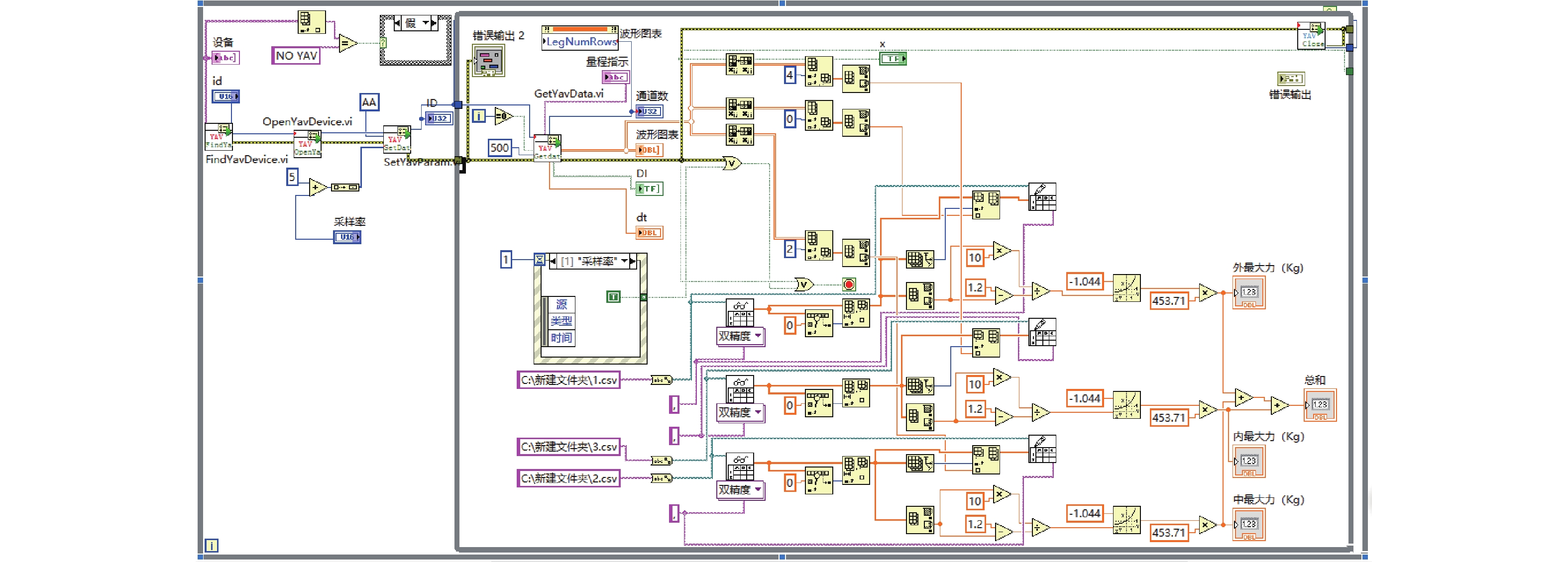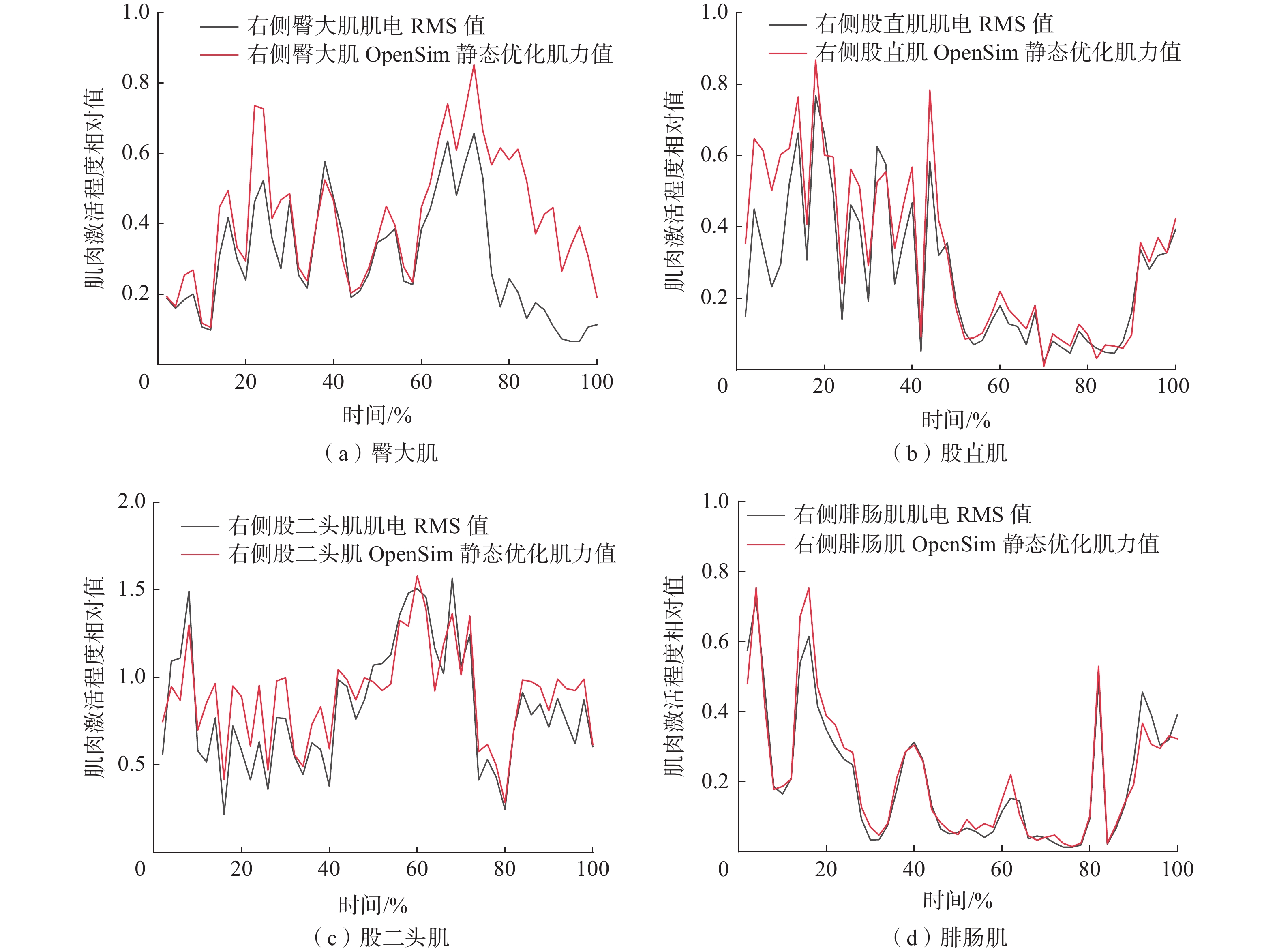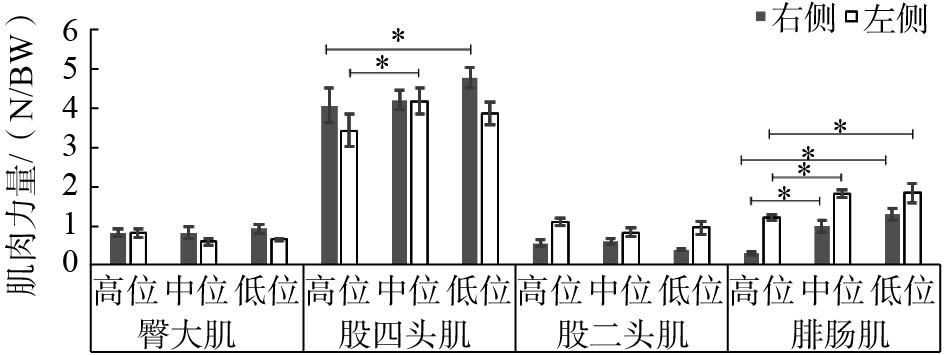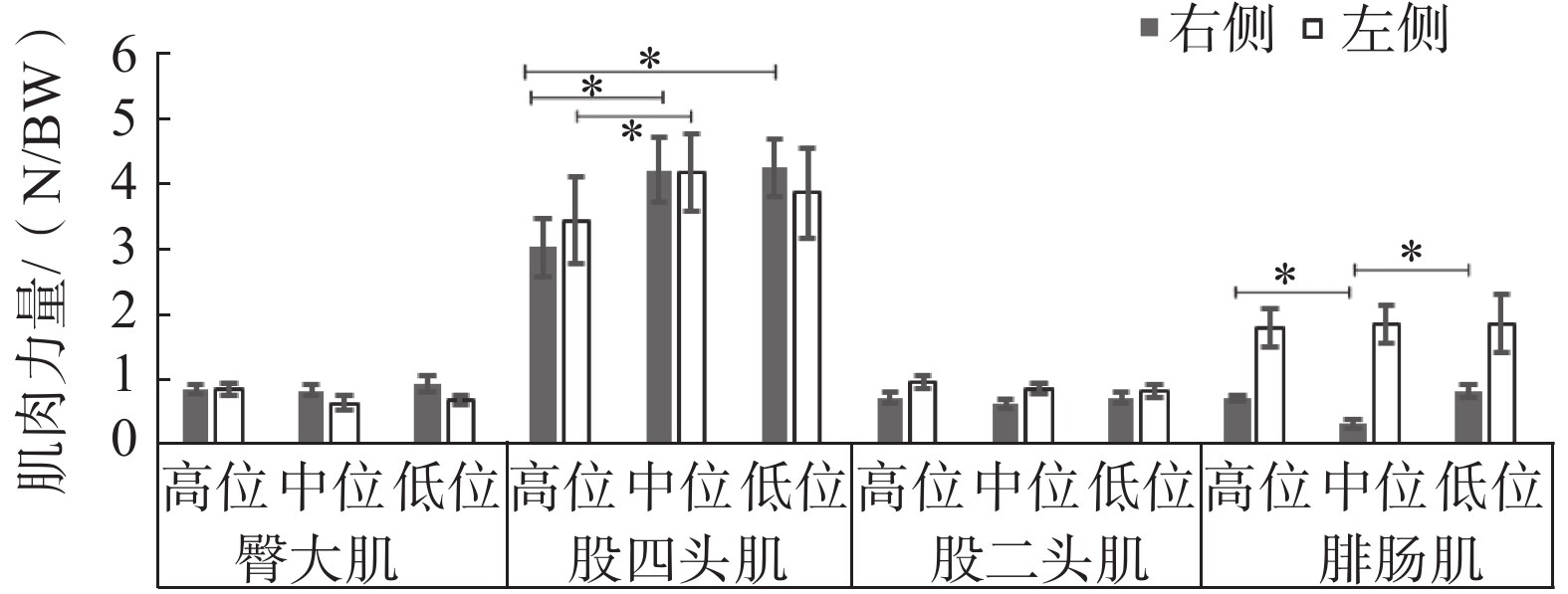Model of Shoulder Tackle Lower-Extremity Movement for Elite Female Rugby Players and the Effect of Its Muscle Strength on Impact Force
-
摘要:目的
建立肩扑搂下肢运动模型,分析其肌群运动特征,为技术学习和专项力量训练提供理论参考与依据,提高技术水平和防守能力。
方法采用力量测试仪、测力台、肌电、Vicon等系统测试18名女子橄榄球运动员肩扑搂生物力学指标,运用OpenSim Static Optimization(OSO)软件建立下肢运动模型。
结果①肩扑搂撞击平均力量为体质量的0.86~1.25倍;②同一体位肩扑搂下肢肌群肌力左右侧存在显著性差异(P<0.05)。③不同体位下肢同侧同名肌群平均肌力:正架肩扑搂右侧股四头肌高位与低位、左侧股四头肌高位与中位、左右侧腓肠肌高位与中低位存在显著性差异(P<0.05)。④肩扑搂下肢肌群肌力与肩扑搂撞击力量呈正相关关系。
结论①肩扑搂蹬伸以髋关节臀大肌、优势侧膝关节股四头肌和非优势侧踝关节腓肠肌为主左右侧平衡发力。②在肩扑搂技术中下肢优势侧踝关节是运动链中的薄弱环节,优势侧踝关节腓肠肌收缩力量平均为体质量的0.26~1.45倍,最大为体质量的1.20~3.08倍,是下肢运动肌肉链中的薄弱肌群。
Abstract:ObjectiveTo establish the lower-extremity movement model of shoulder tackle for female rugby players and understand its muscle strength characteristics, providing theoretical references for the specialized strength training and technique learning for shoulder tackle.
MethodsThe impact force and biomechanics indexes of shoulder tackle and lower-extremity movement in eighteen Chinese elite female rugby players were synchro- tested by the impact testing system, force platform, sEMG and Vicon system, and lower-extremity movement model was established with OpenSim Static Optimization (OSO) software.
Results① The average force of shoulder tackle was 0.86~1.25 times of body weight. ② There was a significant difference between muscle strength of right side and left side of lower-extremity in the same position of shoulder tackle (P<0.05). ③ The average muscle strength of the same muscle groups of lower-extremity in different body positions were shown with significant differences between high and low body positions of right quadriceps, between high and middle body positions of left quadriceps, and between high and middle and low body positions of gastrocnemius, respectively (P<0.05). ④ There was a positive correlation between the muscle strength of lower-extremity and impact force of shoulder tackle.
Conclusions① Left-and-right-side lower-extremity extension were balanced to produce force in shoulder tackle, and the hip, the dominant knee and the non-dominant ankle of lower-extremity were the main exerting joints. ② The dominant ankle was a relatively weaker one in tackle techniques of lower-extremity. As the contractile strength of the dominant ankle gastrocnemius muscle was 0.26~1.45 times of the body weight on average and 1.20~3.08 times of body weight on the maximum, it proved to be a relatively weaker one in the muscle group chain of lower-extremity movement.
-
Keywords:
- rugby /
- shoulder tackle /
- impact force /
- motion model /
- muscle strength
-
较之其他运动项目,英式橄榄球在中国是个新兴项目,运动基础较为薄弱。目前中国橄榄球协会注册的专业运动员只有1521人,其中男子897人、女子624人。为改善中国橄榄球运动的现状, 2019年中国橄榄球协会在第二届代表大会上通过了《中国橄榄球运动十年发展规划》,在中小学广泛普及推广各式橄榄球运动,实现中国参与橄榄球运动人数突破500万人,关注橄榄球运动的人数达到5000万人的目标[1]。
现阶段,主要通过提高竞技成绩、项目的被关注度和影响力来推动中国英式橄榄球运动的发展。虽然中国女子橄榄球队在2020年东京奥运会取得了第7名的优异成绩,为项目的发展带来了良好契机,但其竞技水平与世界强队之间还存在较大差距。在2020年东京奥运会上中国女子橄榄球队与美国队、澳大利亚队、法国队的比赛中,平均每场净失18分,究其主要原因便是肩扑搂防守失败。
肩扑搂防守利用身体的撞击破坏进攻,争夺球权,是阻止持球队员进攻最有效的技术动作。肩扑搂约占扑搂动作的61%,是使用率最高的防守动作[2-3],同时也是英式橄榄球和美式橄榄球比赛中导致损伤率最高的动作[4-5]。更为重要的是,肩扑搂防守有效率与比赛结果呈正相关,比赛获胜方有效扑搂人次多于失败方,而失败方的肩扑搂总量和无效扑搂人次均多于获胜方[6]。在第28届雅加达亚运会女子7人制橄榄球决赛中,中国队的无效肩扑搂占41%,高于日本队的38%;在2020年东京奥运会女子7人制橄榄球小组赛中,与美国队、澳大利亚队、法国队的肩扑搂成功率相比,中国队的无效肩扑搂分别占60%、52%、50%,远远超过对方的25%、28%、30%,这暴露出当前中国女子橄榄球肩扑搂防守能力的技术短板。
在肩扑搂技术中,力量素质是核心要素,是实现撞击效果的基本保障。研究表明:在联盟式橄榄球(Rugby League)比赛中男子运动员下肢最大力量和爆发力与肩扑搂技术能力相关[7-8];在影响肩扑搂能力的多元回归模型中,下肢力量占9%的影响权重[9];在不同体位的肩扑搂中,下肢力量是肩扑搂防守成功与否的关键因素,对其防守效果具有重要影响[10]。可见,现阶段提高肩扑搂技术水平和撞击力量是提高中国女子橄榄球队防守能力和竞技水平的有效途径,也是缩短中国队与世界强队之间竞技水平差距的有效手段。
已有研究对橄榄球肩扑搂技术的生物力学特征进行了一系列探索,为肩扑搂技术学习提供了坚实的理论基础[11-12],但针对优秀女子橄榄球运动员肩扑搂技术动作的研究还相对匮乏,尤其是下肢力量与肩扑搂防守效果的相关性证据还有待补充。肌肉力量的产生取决于很多因素,主要包括肌肉长度、收缩速度、肌肉活性以及募集的速率等 [13-14]。根据肌肉生理横截面积和肌肉运动在力矩中的贡献程度来估算肌力会影响计算的准确性[15]。在生物力学中应用高速高清摄像机与人体运动的运动学、动力学、人体肌电等同步测试,获取人体运动信息并进行完整分析,使运动影像解析系统的功能、质量、测试速度和测试精度等都有了很大程度的提高。然而,采用图像解析方法研究人体运动特征存在两方面的缺陷:①较难检测肌肉产生的力量;②仅用于分析单个运动环节,很难与复杂的人体动态系统建立合理的因果关系[16-17]。
OpenSim Static Optimization (OSO)软件采用 JavaScript 编程语言,以肌肉形态参数为基础建立人体肌肉骨骼模型,通过肌肉力带动关节运动,模拟人体运动,输出关节运动学、肌肉活性、肌肉收缩肌力和肌肉肌腱拉伸变化等生理参数[18]。OSO建模的可靠性在体育学与医学研究中已经被验证[19-20]。为了更加准确、直接地测量肩扑搂下肢肌群收缩力量,本文运用撞击力量测试仪、测力台、肌电和Vicon系统测试,获取肩扑搂下肢运动学指标。同时,采用Visual 3D、SIMI图像分析软件和OSO软件,通过OSO建立下肢运动模型,获得肩扑搂下肢运动的肌肉激活程度和肌肉力量信息。OSO肌肉模型将关节净力矩分解为每个时刻的单个肌肉力量,每一帧(或步)进行独立计算,结合人体生理学几何参数、运动学参数和作用于人体的外部负荷力(地反力),优化得到即刻运动的关节净力矩,在实际肌肉力的阈值内计算出运动时刻单块肌肉的收缩肌力和激活水平[20]。同时,将这一结果与测试的表面肌电值相比较,可以判断模型的可靠性。通过建立肩扑搂下肢运动模型,进行肩扑搂撞击力量影响因素的相关研究,可为橄榄球运动肩扑搂技术学习和专项力量训练提供理论参考,为橄榄球运动科学研究提供中国证据。
1. 研究对象与方法
1.1 研究对象
测试对象为18名上海市女子橄榄球队运动员(健将级运动员13人,一级运动员5人),其中2名运动员参加了2020年东京奥运会;平均年龄(19.7±3.1)岁,运动年限(5.8±2.2)年,身高(168.4±3.5)cm,体质量(62.9±5.3)kg。安排统一测试,测试时间为训练大周期的中期、小周期的力量训练单元,在1周内完成测试。
1.2 研究方法
1.2.1 测试法
(1)肩扑搂撞击力量测试。采用自主研发的力量测试仪(专利号:ZL 201910594285.9)进行。测试仪由硬件和软件构成:硬件主要包括力量传感器、数据采集卡和计算机,进行信号的采集、转换、传输、储存和显示;软件包括应用程序和硬件驱动程序,应用程序实现数据采集程序的设计和控制,硬件驱动程序用于完成数据采集卡工作模式的设置。具体如图1、图2所示。
(2)肩扑搂下肢运动学指标测试。采用Vicon动作捕捉系统、肌电和三维测力台同步进行。①采用英国Vicon Motion System公司生产的红外高速运动捕捉系统和10个MX13型摄像头进行动作捕捉,采样频率为200 Hz,配套的标志点为直径14 mm的红外反光marker球。受试者热身后粘贴marker点于双侧肩峰、第7颈椎棘突、双侧足踝、下肢及骨盆。反光标记点包括环节标记点(双侧肩峰、第7颈椎棘突、双侧大转子、骨盆的双侧髂脊上缘、髂前上棘和髂骨后的后骶骨处,双侧的膝内、膝外、踝内、踝外,足跟正后方的跟骨结节处、足尖、第1和第5跖骨头)以及通过粘贴、捆绑固定在两侧大腿和小腿环节上的4组追踪点。每组环节追踪点粘贴在贴合环节外形的热塑板上,以保证4个反光标记点在环节运动时相对位置保持不变。受试者颈椎、肩峰、骨盆和双侧下肢反光点安放位置参照Visual 3D分析软件默认的下肢模型marker点放置方式,共34(测试时去掉撞击肩峰上的1个点)枚反光标记点。②采用Delsys 无线肌电采集系统测试下肢伸肌群表面肌电值,采集频率为2000 Hz,共10个无线肌电块粘贴在下肢左右侧的臀大肌、股直肌、股二头肌、腓肠肌和胫骨前肌。③采用瑞士奇石乐公司生产的Kistler三维测力台(长×宽×高:90 cm×60 cm×10 cm,型号为9287B,内置信号放大器,最大侧向力和垂直力分别可达10 kN和20 kN)测试下肢蹬伸地反力。采样频率为1000 Hz,使用Butterworth二阶双向低通滤波器滤波动力学数据,截止频率为50 Hz。
(3)测试设备的同步。测力台和Vicon系统通过模数转换器连接并同步构成,Delsys无线肌电采集系统通过同步盒与Vicon系统进行同步。
(4)测试方案。测试在室内22 ℃恒温条件下进行。15 min热身活动后,准备姿势采用比赛中习惯的肩扑搂站位,双脚在测力台上从静止开始,分别用正反架在高、中、低体位进行3次全力有效撞击,每次撞击时间间隔120 s,测量结果数据以平均值进行统计。
1.2.2 数据处理与统计学方法
(1)撞击力量数据处理。按照运动员肩扑搂姿势分前、后肢体进行统计:正架为优势侧撞击,同侧腿在前;反架则为非优势侧撞击,同侧腿在前。如优势侧为右肩:正架为右肩撞击,右腿在前;反架则为左肩撞击,左腿在前[21]。本文受试者中有2人的优势侧是左肩,以优势侧分组进行统计分析。
(2)OSO数据导入。模型采用Besier等[22]的测试方案确定髋关节和膝关节中心点,采用Saxby等[23]的方案计算股骨和胫骨的长度。在Visual 3D中导入运动员静态标定的.c3d文件,个性化修改运动员的身高、体质量,随后将建好的静态人体模型.mdh文件套用于动态数据.c3d文件完成静态模型建立。静态优化模型肌肉力矩方程:
$$ {M_j} = {\sum}_{{\rm{muscle}}\;{\rm{moment}}} + {\sum}_{{\rm{moments}}\;{\rm{due}}\;{\rm{to}}\;{\rm{other}}\;{\rm{structures}}} $$ (1) $$ {M}_{j}=\sum _{f=1}^{nf}{F}_{f}{r}_{f}-\sum _{e=\int }^{ne}{F}_{e}{r}_{e} $$ (2) 其中,nf为屈肌数,ne为伸肌数;rf为屈肌力矩臂,re为伸肌力矩臂。①OSO模型加载。对OpenSim自带模型“gait2392_simbody.osim”进行修改,将92块肌肉运动等速肌力阈值范围扩大3倍,然后在OpenSim软件中打开软件自带的Gait_2392模型,加载肩扑搂模型。②OSO生物力学指标加载。输入肩扑搂的运动学指标(Visual 3D、SIMI)和动力学指标(地面反作用力)进行静态优化,在每一步中更新模型坐标、外部载荷,并计算产生模型加速度所需的肌肉收缩力和激活程度。
(3)统计分析。对于采用体质量进行标准化处理(F/WB)之后的肩扑搂撞击力量和下肢髋、膝、踝关节肌群静态优化肌力的数据,运用SPSS 25统计软件取平均值和最大值进行参数检验。采用单样本K-S检验对符合正态分布的数据进行Z-score标准化,剔除中心化标准化值
$ ({x}-\mathrm{\mu })/\mathrm{\delta } $ ,[−3,3]以外的数据,统计数据以平均数±标准差表示。①统计OSO的肌力值。对同体位左右侧的臀大肌、股四头肌、股二头肌和腓肠肌进行配对样本t检验和配对样本非参数检验(Wilcoxon signed-rank检验)。②以肩扑搂撞击力量为观察变量,正反架不同体位左右侧臀大肌、股四头肌、股二头肌和腓肠肌为控制变量,进行相关性分析,R<0.6或Rho≥0.5,表示在0.05级别显著性相关;R<1或Rho≥0.6,表示在0.01级别显著性相关。2. 研究结果
2.1 肩扑搂撞击力量测试结果
肩扑搂撞击力量测试结果如表1所示。肩扑搂撞击平均力量为体质量的0.86~1.25倍。
表 1 不同体位正反架肩扑搂撞击力量测试结果(n=18)Table 1. Impact force of front and reverse shoulder tackle in different positions (n=18)类别 正架肩扑搂 反架肩扑搂 高位 中位 低位 高位 中位 低位 撞击力量 1.06±0.09 1.19±0.06 1.18±0.07 1.00±0.14 1.15±0.08 1.10±0.11 非参数检验P 0.200 0.200 0.200 0.200 0.089 0.053 2.2 肩扑搂技术OSO结果的验证
采用基准数据比对法验证模型仿真结果的可靠性。将OpenSim静态优化的肌肉激活水平数据与实验采集的表面肌电信号(sEMG)进行对比验证[24-25],如图3、图4所示,在整个动作过程中静态优化结果和肩扑搂蹬伸伸肌sEMG峰值出现的时刻以及曲线形态基本一致,表明模拟仿真结果具有较好的可信度。
2.3 OSO下肢左右侧肌群肌力比较与相关性
同一体位肩扑搂蹬伸下肢肌群力量左右侧比较结果如表2所示。在正架高位肩扑搂技术中,臀大肌最大肌力左右侧存在显著性差异(P<0.05),右侧大于左侧;股四头肌、股二头肌和腓肠肌肌力平均值和最大值左右侧存在显著性差异(P<0.05),股四头肌肌力右侧大于左侧,腓肠肌肌力左侧大于右侧。在正架中位肩扑搂技术中,臀大肌、股四头肌、股二头肌和腓肠肌最大肌力左右侧存在显著性差异(P<0.05),臀大肌右侧大于左侧,股四头肌、股二头肌和腓肠肌左侧大于右侧。在正架低位肩扑搂技术中,臀大肌、股四头肌、股二头肌和腓肠肌肌力平均值和最大值左右侧存在显著性差异(P<0.05),臀大肌和股四头肌的平均肌力右侧大于左侧,臀大肌最大肌力右侧大于左侧,股四头肌最大肌力左侧大于右侧;股二头肌和腓肠肌的平均肌力和最大肌力左侧大于右侧。
表 2 正架肩扑搂下肢肌群肌力左右侧比较结果(n=18)Table 2. Comparison of the muscle strength of lower-extremity between the left and right in front shoulder tackle (n=18)下肢肌群 右侧 左侧 平均值 最大值 平均值 最大值 高
位臀大肌 0.83±0.09 2.25±0.37 0.82±0.11 1.78±0.25★ 股四头肌 4.05±0.44 8.67±1.19 3.43±0.41★ 6.54±0.92★ 腓肠肌 0.30±0.04 1.25±0.05 1.22±0.06★ 3.04±0.08★ 中
位臀大肌 0.83±0.16 1.85±0.58 0.60±0.09 1.39±0.76★ 股四头肌 4.20±0.25 7.05±0.65 4.17±0.32 7.72±0.83★ 股二头肌 0.60±0.07 1.53±0.25 0.84±0.11 2.16±0.24★ 腓肠肌 1.00±0.16 2.21±0.34 1.82±0.09 3.75±0.46★ 低
位臀大肌 0.94±0.11 2.27±0.23 0.66±0.03★ 1.31±0.34★ 股四头肌 4.76±0.27 7.65±0.34 3.85±0.29★ 8.10±0.98★ 股二头肌 0.40±0.03 1.44±0.07 0.96±0.16★ 2.71±0.11★ 腓肠肌 1.30±0.15 2.74±0.34 1.84±0.24★ 3.63±0.09★ 注:非参数检验渐近显著性(双尾),P>0.05;★表示同关节左右侧存在显著性差异。 在反架高位肩扑搂技术中,臀大肌肌力左右侧存在显著性差异(P<0.05),右侧大于左侧;股四头肌、股二头肌和腓肠肌肌力左右侧存在显著性差异(P<0.05),左侧大于右侧。在反架中位肩扑搂技术中,股四头肌最大肌力左右侧存在显著性差异(P<0.05),左侧大于右侧;腓肠肌平均肌力和最大肌力左右侧都存在显著性差异(P<0.05),左侧大于右侧;股二头肌肌力左右侧存在显著性差异(P<0.05),左侧大于右侧。在反架低位肩扑搂技术中,腓肠肌平均肌力和最大肌力左右侧均存在显著性差异(P<0.05),左侧大于右侧。具体如表3所示。
表 3 反架肩扑搂下肢肌群肌力左右侧比较结果(n=18)Table 3. Muscle strength of lower-extremity in reverse shoulder tackle (n=18)下肢肌群 右侧 左侧 平均值 最大值 平均值 最大值 高位股四头肌 3.02±0.44 4.67±0.97 3.25±0.66★ 7.40±0.92★ 中位臀大肌 0.90±0.09 1.94±0.14 0.78±0.11 1.78±0.76 中位股四头肌 4.21±0.09 7.15±0.65 4.36±0.08 7.93±0.83★ 中位腓肠肌 0.30±0.08 1.13±0.14 2.52±0.29★ 3.91±0.35★ 低位臀大肌 0.92±0.12 2.04±0.25 0.80±0.08 1.92±0.24 低位股四头肌 4.24±0.45 6.77±0.55 4.04±0.69 7.35±0.75 低位腓肠肌 0.80±0.09 2.46±0.26 2.59±0.45★ 4.27±0.23★ 注:非参数检验渐近显著性(双尾),P>0.05;★表示同关节左右侧存在显著性差异。 在肩扑搂静态优化模型中,针对不符合正态分布的下肢肌群肌力值数据,采用中位数比较大小,如表4所示。
表 4 肩扑搂下肢肌群肌力(n=18)Table 4. Muscle strength of lower-extremity of shoulder tackle (n=18)肌力 中位数 Z P 正架高位右侧股二头肌 0.60 2.192b 0.028 正架高位左侧股二头肌 1.18 反架高位右侧臀大肌 0.81 2.192b 0.042 反架高位左侧臀大肌 0.61 反架高位右侧腓肠肌 0.70 −1.192c 0.023 反架高位左侧腓肠肌 1.78 反架高位右侧股二头肌 0.70 −2.666c 0.038 反架高位左侧股二头肌 0.94 反架中位右侧股二头肌 0.60 −2.756c 0.04 反架中位左侧股二头肌 0.84 注:非参数检验渐近显著性(双尾),P<0.05;b表示基于正秩,c表示基于负秩。 肩扑搂蹬伸下肢左右侧肌群平均肌力的关系如表5所示。在正架肩扑搂中,右侧股四头肌与左侧腓肠肌呈正相关,左侧股四头肌与右侧腓肠肌呈正相关;在反架肩扑搂中,左侧股四头肌与左侧腓肠肌呈正相关,左侧股二头肌与右侧腓肠肌呈负相关。
表 5 肩扑搂下肢左右侧肌群肌力关系Table 5. Correlation between the left and right of muscle strength of lower-extremity of shoulder tackle类别 正架 反架 右侧股
四头肌左侧股
四头肌右侧
腓肠肌左侧
腓肠肌正架 左侧腓肠肌 0.740** 右侧腓肠肌 0.697** 反架 左侧股四头肌 0.838** 左侧股二头肌 −0.85★★ 注:**表示皮尔逊检验R在0.01级别显著性相关,★★表示斯皮尔曼检验Rho在0.01级别显著性相关。 不同体位肩扑搂蹬伸下肢同侧同名肌群肌力平均值的比较结果如图5、图6所示。在正架肩扑搂中,右侧股四头肌高位与低位之间存在显著性差异,高、低位的肌力分别为体质量的(4.05±0.44)倍和(4.76±0.27)倍,左侧股四头肌高位与中位之间存在显著性差异,高、中位的肌力分别为体质量的(3.43±0.41)倍和(4.17±0.32)倍;左右侧腓肠肌高位与中、低位之间存在显著性差异,高、中、低位右侧的肌力分别为体质量的(0.30±0.04)倍、(1.00±0.16)倍、(1.30±0.15)倍,高、中、低位左侧的肌力分别为体质量的(1.22±0.06)倍、(1.82±0.09)倍、(1.84±0.24)倍。在反架肩扑搂中,右侧股四头肌高位与中、低位之间存在显著性差异,左侧股四头肌高位与中位之间存在显著性差异,右侧腓肠肌中位与高、低位之间存在显著性差异。
2.4 OSO下肢肌群肌力与撞击力量的相关性
在肩扑搂蹬伸下肢肌群中,除了高位肩扑搂的股二头肌肌力与肩扑搂撞击力量没有相关性之外,正反架其他体位肩扑搂左右侧臀大肌、股四头肌、股二头肌和腓肠肌肌力均与肩扑搂撞击力量呈正相关关系。其中,不同体位肩扑搂的右侧股四头肌肌力与肩扑搂撞击力量正相关程度最高,中低位肩扑搂左侧腓肠肌肌力与撞击力量正相关程度较高,具体如表6所示。
表 6 肩扑搂下肢肌群平均肌力与撞击力量的相关性(n=18)Table 6. Correlation between the average strength of low-extremity and the impact force of shoulder tackle (n=18)下肢肌群 正架肩扑搂撞击力量 反架肩扑搂撞击力量 左侧 右侧 左侧 右侧 高位 臀大肌 0.551* 0.576* 0.563★ 0.563★ 股四头肌 0.664** 0.764** 0.556★ 0.578★ 腓肠肌 0.637** 0.558* 0.558★ 0.541★ 中位 臀大肌 0.550* 0.670** 0.548* 0.618** 股四头肌 0.673** 0.771** 0.735** 0.704** 股二头肌 0.513* 0.545* 0.510★ 0.565★ 腓肠肌 0.628** 0.515* 0.639** 0.502* 低位 臀大肌 0.617** 0.718** 0.638** 0.648** 股四头肌 0.721** 0.719** 0.699** 0.710** 股二头肌 0.513* 0.616** 0.577★ 0.550★ 腓肠肌 0.601** 0.522* 0.612** 0.511* 注:*、**分别表示皮尔逊检验R在0.05级别和0.01级别显著性相关,★、★★分别表示斯皮尔曼检验Rho在0.05级别和0.01级别显著性相关。 3. 分析与讨论
3.1 OSO与其他方法的比较
与Computed Muscle Control (CMC)和Neuromusculosketetal Tarckong (NT)仿真建模软件相比,OSO建模更加高效、便捷,且计算肌肉力量的稳定性较高[25-27]。OSO运用逆向动力学建模,通过最小化每个时刻的独立于时间的性能标准,将净关节力矩分解为单个肌肉力,仅需输入身高、体质量、运动学V3D数据和动力学地面反作用力等指标就可以直接优化建模,优化计算成本小[28-30]。研究[25]表明,在走与跑的运动中,OSO静态优化建模的效率约是CMC和NT的5倍。
CMC和NT都是以正向动力学模拟运动,设计方法相似,CMC建模虽然可以解释与时间相关的肌肉收缩力量和激活程度,但需要很高的计算成本;NT在建模计算中肌肉活动及关节力矩误差的平方和时间间隔最小。Lin等[25]的研究表明,在关节力矩精确的走和跑的运动模型中,运用OSO、CMC、NT 3种方法估算肌肉力量,结果没有显著性差异,并且静态优化计算走和跑下肢主要伸肌肌群在水平面、冠状面和矢状面运动时,OSO下肢关节净力矩均方根差小于1 Nm,分别优于CMC的8 Nm(水平面和冠状面)和NT的15 Nm。
OSO可以采用OpenSim和MATLAB软件仿真平台处理数据,而CMC只能运用OpenSim、NT只能运用MATLAB进行数据处理[31-32]。然而,采用OSO方法建模必须依靠收集和处理的环节运动学指标参数,才能确保环节推导计算的肌肉肌力和激活程度的精确性, OSO在计算更为精确的肌肉力量时需要解释肌肉的生理特征[33],且其静态优化计算以时间为单位的肌肉力量[34],基于逆向动力学方法不能恰当解释肌肉之间协同运动的潜在规律[35-36],因此也存在一定的局限性。
本文探索影响肩扑搂撞击力量的主要因素,通过建立运动模型了解肩扑搂动作下肢运动的特征,尤其是下肢关节肌群收缩肌力对肩扑搂撞击力量的影响。收集18名受试者每人18条数据,即正反架肩扑搂分别在高、中、低位每个体位3次动作的数据,并且采用OSO和CMC分别进行运动建模。运用OSO方法在3天内完成了18人的正反架肩扑搂高、中、低位下肢运动建模,得到了下肢主要伸肌肌群肌力和激活程度等指标,同时在MATLAB软件平台完成数据处理。然而,运用CMC方法处理1个人的数据就用了3天时间,1个星期只完成2名测试对象的建模。为了提高研究效率,并结合本文实际需求,最终选用OSO作为估算人体运动中肌肉力量的方法。
3.2 肩扑搂OSO建模的可靠性
OSO自带模型采集普通人群数据进行建模和计算,每块肌肉设置不同的等速肌力力矩阈值,下肢肌群中最小的为156 Nm,最大的为3549 Nm。为了优化参加2020年东京奥运会的女子橄榄球运动员肩扑搂下肢运动,针对OpenSim自带模型“gait2392_simbody.osim”进行修改,将92块肌肉运动等速肌力阈值范围扩大3倍,然后进行肩扑搂的OSO运算,得到肌力和肌肉激活程度。将OSO的结果(3DGaitModle2392_StaticOptimization activation值)与肩扑搂蹬伸下肢肌肉sEMG的RMS值进行比较,通过其曲线变化趋势的相似度判断静态优化结果的可靠性[24, 37-39] 。研究结果显示,在整个动作过程中静态优化结果和下肢肌肉sEMG峰值出现的时刻及曲线形态基本一致,验证了模型仿真结果的可靠性,通过导出3DGaitModle2392_StaticOptimization_force.sto文件,最终得到肩扑搂下肢运动中单块肌肉的收缩力量。
3.3 肩扑搂OSO模型下肢肌群肌力特征
本文结果显示,在正架肩扑搂下肢蹬伸运动中,优势侧(右侧)股四头肌与非优势侧(左侧)腓肠肌力量较对侧更大,分别与对侧肌群力量存在正相关关系。一方面,这表明在正架肩扑搂下肢蹬伸运动中,优势侧膝关节和非优势侧踝关节的伸肌是主要发力肌群;同时,随着身体重心的下降,即膝关节角度的增加和踝关节角度的减小,优势侧股四头肌力量增加,中位肩扑搂优势侧股四头肌平均收缩力量较高、低位更大,低位肩扑搂非优势侧腓肠肌最大收缩肌力和平均收缩肌力较高、中位更大。另一方面,这表明在肩扑搂下肢蹬伸运动中,下肢优势侧膝关节和非优势侧踝关节的协调发力是保持身体姿态平衡和肩扑搂技术稳定的基础。
反架肩扑搂下肢蹬伸运动的典型特征是非优势侧踝关节腓肠肌的发力仍然较优势侧更大。这表明在肩扑搂技术中,运动员习惯以非优势侧踝关节发力,以非优势侧髋膝发力为主(前腿)。在实际比赛中,反架肩扑搂技术使用率较低,运动员主观上不重视反架肩扑搂技术的学习和训练,对反架肩扑搂技术的掌握较正架技术差,反架肩扑搂技术水平没有达到自动化和动力定型的阶段。
生物力学研究[40-41]表明,以解剖学解释肌肉的功能是不充分的,因为在多关节运动中一块肌肉可以对它的不跨关节产生作用,而双关节肌肉可以在跨关节处产生与其力矩方向相反的作用。在肢体一端不受约束的情况下,生物力学与解剖学解释是一致的[42]。股后肌群跨髋关节和膝关节,腓肠肌跨膝关节和踝关节,在股四头肌的配合下,腘绳肌和腓肠肌不但具有伸髋和伸踝的作用,同时也具有伸膝的作用。运用肌肉屈伸功能以动作而定原理,从两方面分析肩扑搂蹬伸中膝、踝关节股四头肌、腓肠肌力量与髋、膝、踝关节贡献度错位的矛盾:一方面,臀大肌和腘绳肌收缩伸髋;另一方面,在下肢一端固定的条件下股四头肌和腓肠肌收缩也有伸髋的作用。此外,肌肉力量与关节做功是2个不同的生物力学概念,力量的大小不能等同于做功的大小。不同体位肩扑搂蹬伸中髋、膝、踝关节伸肌群力量的差异,尤其是其股四头肌和腓肠肌肌力的差异与肌肉发力、关节角度相关。在反架肩扑搂技术中,优势侧与非优势侧力量的差异,尤其是非优势侧腓肠肌力量较大的特征表明正架技术对反架技术有影响,运动员已经形成正架技术肌肉发力的动力定型和动作自动化,影响了反架技术肌肉的发力。针对正反架肩扑搂技术存在差异的现象,建议橄榄球教练员和运动员重视反架肩扑搂技术的学习和训练。
3.4 下肢肌群肌力与肩扑搂防守效果的关系
肩扑搂下肢动作是非对称非垂直起跳的蹬伸(蹬跳),下肢多关节运动力矩为:净关节力矩(NET)=重力矩(GRA)+互动动力矩(INT)+地面反作用力引起的接触力矩(EXT)+肌肉力矩(MUS)。净关节力矩值反映肌肉力量大小。在肩扑搂蹬伸阶段,伸肌向心收缩产生力矩,其伸肌收缩力量决定蹬伸的垂直和水平冲量。这是肩扑搂蹬伸过程中身体移动速度和撞击力量的主要来源[9-10],而撞击力量是其防守效果的核心影响因素和基础,撞击力量的大小影响持球人进攻的效果和撞击后形成的局面,如进攻被阻断失去球权,进攻速度被延缓,进攻推进距离被缩短,以及形成集阵Scrum、Maul、Ruck的不利体位(进攻队员身体护球水平线偏向防守方)。由此可见,下肢肌群的收缩力量影响防守的效果。
肩扑搂蹬伸下肢肌群收缩力量与撞击力量之间存在相关性。本文结果显示,右侧髋、膝、踝关节伸肌群力量与撞击力量呈正相关,下肢肌群力量与撞击力量之间存在线性关系。左右侧股四头肌和左侧腓肠肌对撞击力量的影响凸显了膝关节和左踝关节(非优势侧)的伸展运动在肩扑搂防守效果中的重要作用,证明了下肢左右侧协调发力不仅是肩扑搂技术质量的保障,也是防守效果的保障。更为重要的是,这种通过测试膝关节伸肌肌力预测和评价肩扑搂防守能力的方式能够帮助教练员选拔人才和合理安排场上防守队员的具体位置及全队的防守战术。这一研究结果将为肩扑搂技术学习和力量训练提供理论参考和依据。
3.5 肩扑搂下肢肌群肌力表现形式和针对性训练
肩扑搂撞击力量测试是运动员在静态站位自我控制蹬伸启动的情况下进行的,蹬伸至撞击前平均时间约为0.3 s,OSO系统可检测到下肢肌群每一帧时间的肌肉力量,即蹬伸阶段的时间/帧数的肌肉力量,相当于肌肉功率(肌肉的爆发力)。统计分析蹬伸阶段肌肉的最大力量和平均力量。运动中肌肉力量的一般表现形式分为最大力量、力量耐力和快速力量,快速力量分为反应力量和启动力量[43]。本文静态优化的肌肉力量以启动力量为主。在橄榄球实际比赛和训练中,以静态和动态(行进间移动)姿势站位的形式进行扑搂防守。移动中进行肩扑搂防守首先需要判断防守时机,即肩扑搂防守依靠下肢肌群的反应力量和起动力量。比赛中肩扑搂是使用率最高的防守动作[2-3],在Rugby Union比赛中平均每场比赛出现200多人次扑搂的情况[44-45],在Rugby League比赛中平均每场比赛多达300人次扑搂[46-48]。为保证肩扑搂的防守效果,需要下肢肌群具有较强的力量耐力。由此可见,在肩扑搂技术中橄榄球运动员下肢力量表现形式以快速力量和力量耐力为主。在提高肩扑搂防守能力的力量训练中,一般力量训练可以采用超等长练习手段,如采用跳跃和深蹲练习等发展下肢肌群启动力量和力量耐力;专项力量可以采用司克兰架练习,发展下肢和躯干肌群力量耐力,撞击shield扑搂包弓形垫练习发展下肢启动力量,扑搂Rolling Tackle Dummy练习发展下肢肌群反应力量。
在肩扑搂蹬伸过程中,下肢运动链所包括的关节力矩已被确定,末端效应器任何力的增加都需要运动链中所有关节力矩同时成比例地增加,在末端效应器发出最大力时,运动链中某些关节力矩达到最大值(在蹬伸阶段某一时刻的身体姿态),而其他关节力矩仅达到次最大值。由于运动过程所涉关节中的一个或多个的力矩不足,末端点力不能进一步增加,这种关节为限制关节,也称薄弱关节。在力量训练过程中,针对不同情况分析、判断限制关节(薄弱关节),从而对其进行针对性训练,可改善整个环节的力或力矩关系,增加末端效应器力或力矩的输出,达到增加速度或力量的运动训练目标。采用OSO建立肩扑搂动作模型可以诊断运动员下肢蹬伸发力是否存在薄弱环节。本文结果显示:优势侧踝关节腓肠肌收缩力量平均为体质量的0.26~1.45倍,最大为体质量的1.20~3.08倍;非优势侧腓肠肌收缩力量平均为体质量的1.16~3.04倍,最大为体质量的2.96~4.50倍。这表明正反架的右侧踝关节力量相对左侧踝关节较弱,同时也表明在正反架肩扑搂蹬伸阶段,下肢关节中右侧踝关节是薄弱关节,也是薄弱的发力环节。建立肩扑搂动作模型有助于教练员或运动员了解在肩扑搂蹬伸过程中哪些是重要的发力环节和发力肌群,如基于正架肩扑搂下肢优势侧膝关节股四头肌和非优势侧踝关节腓肠肌对撞击力量的影响,可进行针对性力量训练,促进训练目标高效实现,提高肩扑搂技术水平等。
4. 结论与建议
4.1 结 论
①肩扑搂蹬伸下肢环节左右侧平衡发力,下肢肌群力量表现形式以快速力量和力量耐力为主。②女子橄榄球运动员下肢髋关节、优势侧膝关节和非优势侧踝关节是肩扑搂蹬伸主要发力关节,臀大肌、优势侧股四头肌和非优势侧腓肠肌是肩扑搂蹬伸发力的主要肌群。③在肩扑搂技术中下肢优势侧踝关节是运动链中的薄弱环节,优势侧踝关节腓肠肌收缩力量平均为体质量的0.26~1.45倍,最大为体质量的1.20~3.08倍,是下肢运动肌肉链中的薄弱肌群。
4.2 建 议
①加强肩扑搂下肢肌群的力量训练。一般力量训练采用超等长练习手段,如采用跳跃和深蹲练习等发展下肢肌群启动力量和力量耐力;专项力量可以采用司克兰架练习发展下肢和躯干肌群力量耐力,撞击shield扑搂包弓形垫练习发展下肢起动力量,扑搂Rolling Tackle Dummy练习发展下肢肌群反应力量;针对肩扑搂下肢运动肌肉链中的薄弱环节优势侧踝关节腓肠肌力量,可采用以掌趾和踝关节为主的退让与超等长练习手段。②提高肩扑搂技术水平和能力。针对优秀运动员加强正架肩扑搂下肢优势侧膝关节股四头肌和双侧踝关节腓肠肌的力量训练;针对初学者形成左右侧肩扑搂均衡防守的意识,淡化单侧扑搂技术的观念,在训练和比赛中培养左右侧肩扑搂均衡防守的习惯和意识。
作者贡献声明:宋校能:提出论文主题,设计实验流程,处理数据,撰写论文;作者贡献声明:徐辉:设计论文框架,核实数据,修改论文;作者贡献声明:吴贻刚:指导实验技术动作,核实数据,指导修改和审核论文。 -
表 1 不同体位正反架肩扑搂撞击力量测试结果(n=18)
Table 1 Impact force of front and reverse shoulder tackle in different positions (n=18)
类别 正架肩扑搂 反架肩扑搂 高位 中位 低位 高位 中位 低位 撞击力量 1.06±0.09 1.19±0.06 1.18±0.07 1.00±0.14 1.15±0.08 1.10±0.11 非参数检验P 0.200 0.200 0.200 0.200 0.089 0.053 表 2 正架肩扑搂下肢肌群肌力左右侧比较结果(n=18)
Table 2 Comparison of the muscle strength of lower-extremity between the left and right in front shoulder tackle (n=18)
下肢肌群 右侧 左侧 平均值 最大值 平均值 最大值 高
位臀大肌 0.83±0.09 2.25±0.37 0.82±0.11 1.78±0.25★ 股四头肌 4.05±0.44 8.67±1.19 3.43±0.41★ 6.54±0.92★ 腓肠肌 0.30±0.04 1.25±0.05 1.22±0.06★ 3.04±0.08★ 中
位臀大肌 0.83±0.16 1.85±0.58 0.60±0.09 1.39±0.76★ 股四头肌 4.20±0.25 7.05±0.65 4.17±0.32 7.72±0.83★ 股二头肌 0.60±0.07 1.53±0.25 0.84±0.11 2.16±0.24★ 腓肠肌 1.00±0.16 2.21±0.34 1.82±0.09 3.75±0.46★ 低
位臀大肌 0.94±0.11 2.27±0.23 0.66±0.03★ 1.31±0.34★ 股四头肌 4.76±0.27 7.65±0.34 3.85±0.29★ 8.10±0.98★ 股二头肌 0.40±0.03 1.44±0.07 0.96±0.16★ 2.71±0.11★ 腓肠肌 1.30±0.15 2.74±0.34 1.84±0.24★ 3.63±0.09★ 注:非参数检验渐近显著性(双尾),P>0.05;★表示同关节左右侧存在显著性差异。 表 3 反架肩扑搂下肢肌群肌力左右侧比较结果(n=18)
Table 3 Muscle strength of lower-extremity in reverse shoulder tackle (n=18)
下肢肌群 右侧 左侧 平均值 最大值 平均值 最大值 高位股四头肌 3.02±0.44 4.67±0.97 3.25±0.66★ 7.40±0.92★ 中位臀大肌 0.90±0.09 1.94±0.14 0.78±0.11 1.78±0.76 中位股四头肌 4.21±0.09 7.15±0.65 4.36±0.08 7.93±0.83★ 中位腓肠肌 0.30±0.08 1.13±0.14 2.52±0.29★ 3.91±0.35★ 低位臀大肌 0.92±0.12 2.04±0.25 0.80±0.08 1.92±0.24 低位股四头肌 4.24±0.45 6.77±0.55 4.04±0.69 7.35±0.75 低位腓肠肌 0.80±0.09 2.46±0.26 2.59±0.45★ 4.27±0.23★ 注:非参数检验渐近显著性(双尾),P>0.05;★表示同关节左右侧存在显著性差异。 表 4 肩扑搂下肢肌群肌力(n=18)
Table 4 Muscle strength of lower-extremity of shoulder tackle (n=18)
肌力 中位数 Z P 正架高位右侧股二头肌 0.60 2.192b 0.028 正架高位左侧股二头肌 1.18 反架高位右侧臀大肌 0.81 2.192b 0.042 反架高位左侧臀大肌 0.61 反架高位右侧腓肠肌 0.70 −1.192c 0.023 反架高位左侧腓肠肌 1.78 反架高位右侧股二头肌 0.70 −2.666c 0.038 反架高位左侧股二头肌 0.94 反架中位右侧股二头肌 0.60 −2.756c 0.04 反架中位左侧股二头肌 0.84 注:非参数检验渐近显著性(双尾),P<0.05;b表示基于正秩,c表示基于负秩。 表 5 肩扑搂下肢左右侧肌群肌力关系
Table 5 Correlation between the left and right of muscle strength of lower-extremity of shoulder tackle
类别 正架 反架 右侧股
四头肌左侧股
四头肌右侧
腓肠肌左侧
腓肠肌正架 左侧腓肠肌 0.740** 右侧腓肠肌 0.697** 反架 左侧股四头肌 0.838** 左侧股二头肌 −0.85★★ 注:**表示皮尔逊检验R在0.01级别显著性相关,★★表示斯皮尔曼检验Rho在0.01级别显著性相关。 表 6 肩扑搂下肢肌群平均肌力与撞击力量的相关性(n=18)
Table 6 Correlation between the average strength of low-extremity and the impact force of shoulder tackle (n=18)
下肢肌群 正架肩扑搂撞击力量 反架肩扑搂撞击力量 左侧 右侧 左侧 右侧 高位 臀大肌 0.551* 0.576* 0.563★ 0.563★ 股四头肌 0.664** 0.764** 0.556★ 0.578★ 腓肠肌 0.637** 0.558* 0.558★ 0.541★ 中位 臀大肌 0.550* 0.670** 0.548* 0.618** 股四头肌 0.673** 0.771** 0.735** 0.704** 股二头肌 0.513* 0.545* 0.510★ 0.565★ 腓肠肌 0.628** 0.515* 0.639** 0.502* 低位 臀大肌 0.617** 0.718** 0.638** 0.648** 股四头肌 0.721** 0.719** 0.699** 0.710** 股二头肌 0.513* 0.616** 0.577★ 0.550★ 腓肠肌 0.601** 0.522* 0.612** 0.511* 注:*、**分别表示皮尔逊检验R在0.05级别和0.01级别显著性相关,★、★★分别表示斯皮尔曼检验Rho在0.05级别和0.01级别显著性相关。 -
[1] 扈建华. 中国橄榄球运动尝试突破迎来发展新契机[N]. 中国体育报, 2019-04-26(4) [2] BURGER N,LAMBERT M I,VILJOEN W,et al. Tackle technique and tackle-related injuries in high-level South African Rugby Union under-18 players:Real-match video analysis[J]. British Journal of Sports Medicine,2016,50(15):932-938 doi: 10.1136/bjsports-2015-095295
[3] ROSS A,GILL N,CRONIN J,et al. The relationship between physical characteristics and match performance in rugby sevens[J]. European Journal of Sport Science,2015,15(6):565-571 doi: 10.1080/17461391.2015.1029983
[4] BENGTSSON H,EKSTRAND J,HÄGGLUND M. Muscle injury rates in professional football increase with fixture congestion:An 11-year follow-up of the UEFA Champions League injury study[J]. British Journal of Sports Medicine,2013,47(12):743-747 doi: 10.1136/bjsports-2013-092383
[5] FEELEY B T,KENNELLY S,BARNES R P,et al. Epidemiology of National Football League training camp injuries from 1998 to 2007[J]. The American Journal of Sports Medicine,2008,36(8):1597-1603 doi: 10.1177/0363546508316021
[6] VAN ROOYEN M,YASIN N,VILJOEN W. Characteristics of an 'effective' tackle outcome in Six Nations rugby[J]. European Journal of Sport Science,2014,14(2):123-129 doi: 10.1080/17461391.2012.738710
[7] GABBETT T J. Influence of fatigue on tackling ability in rugby league players:Role of muscular strength,endurance,and aerobic qualities[J]. PLoS One,2016,11(10):e0163161 doi: 10.1371/journal.pone.0163161
[8] PILGRIM S. Knee extension strength and hamstrings-to-quadriceps imbalances in elite soccer players[J]. International Journal of Sports Medicine,2015,37(2):119-124 doi: 10.1055/s-0035-1559686
[9] GABBETT T J,JENKINS D G,ABERNETHY B. Correlates of tackling ability in high-performance rugby league players[J]. Journal of Strength and Conditioning Research,2011,25(1):72-79 doi: 10.1519/JSC.0b013e3181ff506f
[10] GABBETT T J,JENKINS D G,ABERNETHY B. Relationships between physiological,anthropometric,and skill qualities and playing performance in professional rugby league players[J]. Journal of Sports Sciences,2011,29(15):1655-1664 doi: 10.1080/02640414.2011.610346
[11] EDWARDS S,LEE R,FULLER G,et al. 3D biomechanics of rugby tackle techniques to inform future rugby research practice:A systematic review[J]. Sports Medicine-Open,2021,7:39 doi: 10.1186/s40798-021-00322-w
[12] SONG X N,XU H,MENG J,et al. Impact of lower-extremity strength on shoulder tackle of female rugby players measured with sensor system[J]. Sensors and Materials,2021,33(5):1541-1550 doi: 10.18494/SAM.2021.3265
[13] 王砚麟,王克义,章梓星,等. 单曲膝行走步态对下肢力学、肌肉力和肌肉激活度的影响[J]. 哈尔滨工程大学学报,2021,42(9):1363-1372 [14] HUGHES G. A review of recent perspectives on biomechanical risk factors associated with anterior cruciate ligament injury[J]. Research in Sports Medicine,2014,22(2):193-212 doi: 10.1080/15438627.2014.881821
[15] 郭朝,殷跃红. 基于分子马达集体运行机制的骨骼肌收缩动态力学模型:基于分子马达运行机制的骨骼肌生物力学原理:Ⅰ[J]. 中国科学:技术科学,2012,42(6):672-679 [16] 侯亚丽,王向东. 三维运动解析系统在生物力学中的应用与发展趋势[J]. 成都工业学院学报,2016,19(2):71-74 [17] 张春礼,王军,徐新智,等. 一种视频图像微机分析三维运动检测系统[J]. 生物医学工程学杂志,1994,11(4):344-350 [18] DE SOUSA A C C,FREIRE J P C D,BO A P L. Integrating hip exosuit and FES for lower limb rehabilitation in a simulation environment[J]. IFAC-PapersOnLine,2019,51(34):302-307 doi: 10.1016/j.ifacol.2019.01.030
[19] 梅齐昌,相亮亮,孙冬,等. 长距离跑后“足外翻”姿态增加膝关节内侧接触力:基于OpenSim肌骨建模及机器学习预测的研究[J]. 体育科学,2019,39(9):51-59 [20] 郭超,何育民,孙朝阳,等. OpenSim 环境下人体下肢行走生物力学特性研究[J]. 机械科学与技术,2021,40(9):1355-1360 [21] KAWASAKI T,TANABE Y,TANAKA H,et al. Kinematics of rugby tackling:A pilot study with 3-dimensional motion analysis[J]. The American Journal of Sports Medicine,2018,46(10):2514-2520 doi: 10.1177/0363546518781808
[22] BESIER T F,STURNIEKS D L,ALDERSON J A,et al. Repeatability of gait data using a functional hip joint centre and a mean helical knee axis[J]. Journal of Biomechanics,2003,36(8):1159-1168 doi: 10.1016/S0021-9290(03)00087-3
[23] SAXBY D J,MODENESE L,BRYANT A L,et al. Tibiofemoral contact forces during walking,running and sidestepping[J]. Gait & Posture,2016,49:78-85
[24] KAR J,QUESADA P M. A musculoskeletal modeling approach for estimating anterior cruciate ligament strains and knee anterior-posterior shear forces in stop-jumps performed by young recreational female athletes[J]. Annals of Biomedical Engineering,2013,41(2):338-348 doi: 10.1007/s10439-012-0644-y
[25] LIN Y C,DORN T W,SCHACHE A G,et al. Comparison of different methods for estimating muscle forces in human movement[J]. Proceedings of the Institution of Mechanical Engineers,Part H:Journal of Engineering in Medicine,2012,226(2):103-112 doi: 10.1177/0954411911429401
[26] THELEN D G,ANDERSON F C,DELP S L. Generating dynamic simulations of movement using computed muscle control[J]. Journal of Biomechanics,2003,36(3):321-328 doi: 10.1016/S0021-9290(02)00432-3
[27] THELEN D G,ANDERSON F C. Using computed muscle control to generate forward dynamic simulations of human walking from experimental data[J]. Journal of Biomechanics,2006,39(6):1107-1115 doi: 10.1016/j.jbiomech.2005.02.010
[28] 李琳杰,成万祥. 基于OpenSim技术的跨栏跟腱仿真分析[J]. 天津体育学院学报,2013,28(6):502-507 doi: 10.3969/j.issn.1005-0000.2013.06.009 [29] 戎科,钱竞光. 运动生物力学仿真建模软件LifeMOD和OpenSim的建模比较[J]. 南京体育学院学报(自然科学版),2015,14(5):38-42 [30] SETH A,PANDY M G. A neuromusculoskeletal tracking method for estimating individual muscle forces in human movement[J]. Journal of Biomechanics,2007,40(2):356-366 doi: 10.1016/j.jbiomech.2005.12.017
[31] ANDERSON F C,PANDY M G. Dynamic optimization of human walking[J]. Journal of Biomechanical Engineering,2001,123(5):381-390 doi: 10.1115/1.1392310
[32] DELP S L,ANDERSON F C,ARNOLD A S,et al. OpenSim:Open-source software to create and analyze dynamic simulations of movement[J]. IEEE Transactions on Bio-Medical Engineering,2007,54(11):1940-1950 doi: 10.1109/TBME.2007.901024
[33] DAVY D T,AUDU M L. A dynamic optimization technique for predicting muscle forces in the swing phase of gait[J]. Journal of Biomechanics,1987,20(2):187-201 doi: 10.1016/0021-9290(87)90310-1
[34] PATRIARCO A G,MANN R W,SIMON S R,et al. An evaluation of the approaches of optimization models in the prediction of muscle forces during human gait[J]. Journal of Biomechanics,1981,14(8):513-525 doi: 10.1016/0021-9290(81)90001-4
[35] AN K N,KAUFMAN K R,CHAO E Y S. Physiological considerations of muscle force through the elbow joint[J]. Journal of Biomechanics,1989,22(11-12):1249-1256 doi: 10.1016/0021-9290(89)90227-3
[36] PANDY M G,GARNER B A,ANDERSON F C. Optimal control of non-ballistic muscular movements:A constraint-based performance criterion for rising from a chair[J]. Journal of Biomechanical Engineering,1995,117(1):15-26 doi: 10.1115/1.2792265
[37] 黄尚军,伍勰,阮棉芳,等. 4种算法评估落地动作中ACL负荷的对比研究[J]. 体育科学,2018,38(3):73-79 [38] 梅齐昌,顾耀东,孙冬,等. 基于影像学构建个体化OpenSim下肢肌骨模型的生物力学研究应用进展[J]. 医用生物力学,2020,35(2):259-264 [39] SASAKI K,NEPTUNE R R. Individual muscle contributions to the axial knee joint contact force during normal walking[J]. Journal of Biomechanics,2010,43(14):2780-2784 doi: 10.1016/j.jbiomech.2010.06.011
[40] ZAJAC F E. Muscle coordination of movement:A perspective[J]. Journal of Biomechanics,1993,26(Suppl.1):109-124
[41] ZAJAC F E,GORDON M E. Determining muscle's force and action in multi-articular movement[J]. Exercise and Sport Sciences Reviews,1989,17:187-230
[42] 苏利强,张克峰,温岱宗,等. 运动生理学的学科起源:基于骨骼肌相关研究的追溯[J]. 天津体育学院学报,2019,34(4):315-322 [43] 田麦久. 运动训练学[M]. 2版. 北京: 人民体育出版社, 2000: 191 [44] FULLER C W,ASHTON T,BROOKS J H M,et al. Injury risks associated with tackling in Rugby Union[J]. British Journal of Sports Medicine,2010,44(3):159-167 doi: 10.1136/bjsm.2008.050864
[45] QUARRIE K L,HOPKINS W G. Tackle injuries in professional Rugby Union[J]. The American Journal of Sports Medicine,2008,36(9):1705-1716 doi: 10.1177/0363546508316768
[46] 宋校能,虞致国,徐辉,等. 英式橄榄球女子运动员肩扑搂撞击力量测试仪的研发[J]. 中国体育科技,2021,57(7):69-77 [47] ORR R,CHENG H L. Incidence and characteristics of injuries in elite Australian junior rugby league players[J]. Journal of Science and Medicine in Sport,2016,19(3):212-217 doi: 10.1016/j.jsams.2015.03.007
[48] KING D,HUME P A,CLARK T. Nature of tackles that result in injury in professional rugby league[J]. Research in Sports Medicine (Print),2012,20(2):86-104 doi: 10.1080/15438627.2012.660824
-
期刊类型引用(4)
1. 李上校,杨进,郝卫亚. 竞技体育生物力学2023年度研究进展. 医用生物力学. 2024(04): 563-575 .  百度学术
百度学术
2. 时良. 足球运动员单边肌力训练对专项体能的影响研究. 当代体育科技. 2024(29): 15-17 .  百度学术
百度学术
3. 袁雷,孙卓,俞大伟. 疲劳状态下男子自由跤运动员的肌力衰减特征及训练启示. 体育学研究. 2024(05): 79-95 .  百度学术
百度学术
4. 梁慧敏,梁骁. 讲解示范教学法在羽毛球技术教学中的应用研究——基于现场教学与视频教学的比较实验. 当代体育科技. 2023(26): 65-72 .  百度学术
百度学术
其他类型引用(1)




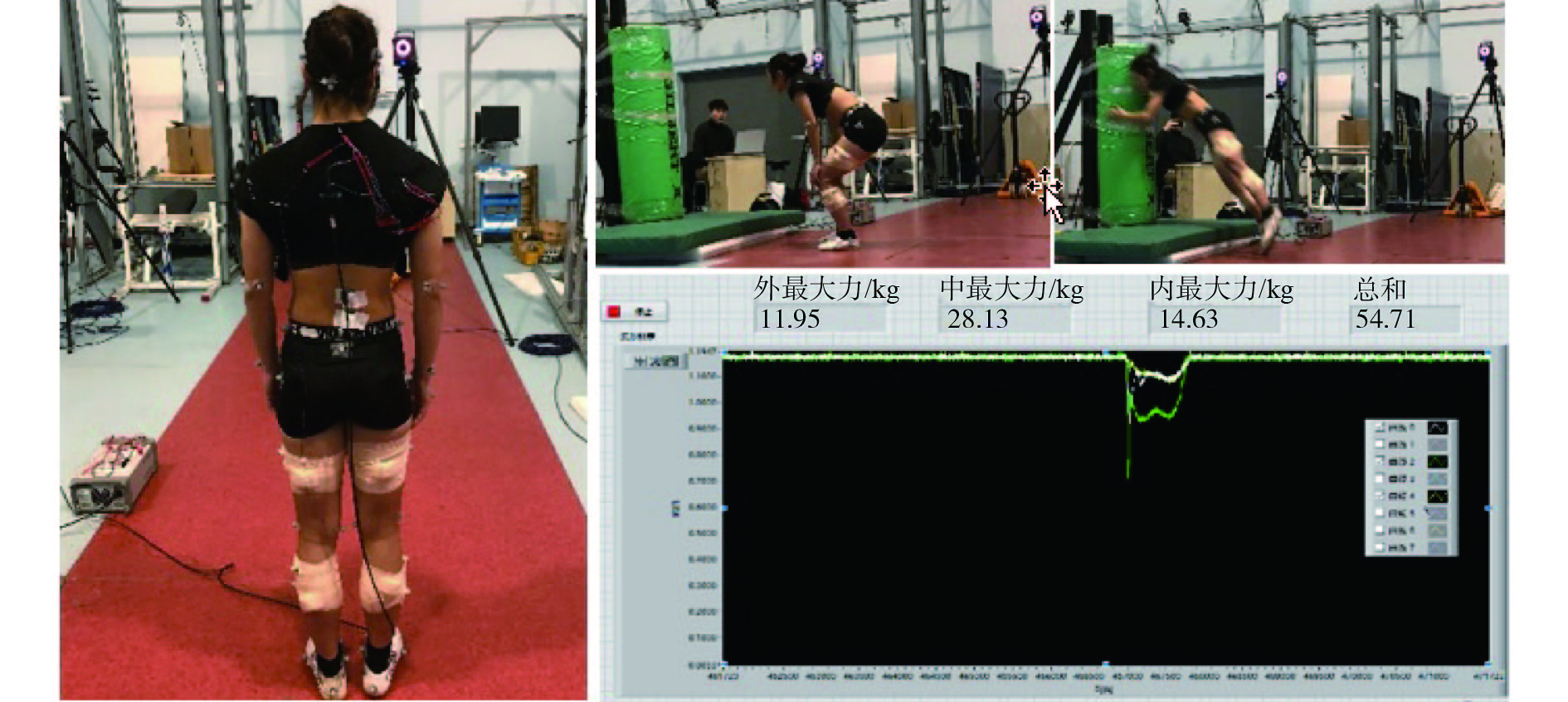
 下载:
下载:
